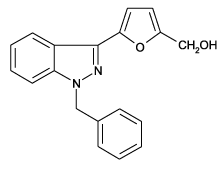Replaces Prod. #: BML-CN223
Nitric oxide (NO) independent, superoxide-sensitive stimulator of soluble guanylyl cyclase (sGC), EC50=18.6μM. Induces concentration-dependent increase in cGMP levels in cultured cells and in rabbit aortic rings. Inhibits platelet adhesion to collagen. Non-specific phosphodiesterase inhibitor. YC-1 inhibits HIF-α activity in tumors resulting in blocked angiogenesis and an inhibition of tumor growth. Inhibits Na+ channel.Binds to [3H]BW202W92.
Product Details
| Formula: | C19H16N2O2 |
| |
| MW: | 304.4 |
| |
| CAS: | 170632-47-0 |
| |
| Purity: | ≥98% (HPLC) |
| |
| Identity: | Identity determined by 1H-NMR. |
| |
| Appearance: | White to pale yellow powder. |
| |
| Solubility: | Soluble in DMSO, methanol or dichloromethane. |
| |
| Shipping: | Ambient Temperature |
| |
| Long Term Storage: | +4°C |
| |
| Handling: | Protect from light. |
| |
| Regulatory Status: | RUO - Research Use Only |
| |
Please mouse over
Product Literature References
Expression of N-WASP is regulated by HiF1α through the hypoxia response element in the N-WASP promoter: A. Salvi & T. Thanabalu; Biochem. Biophys. Rep.
9, 13 (2016),
Abstract;
Full Text
Selection, Analysis and Improvement of Anti-Angiogenesis Compounds Identified by an Anti-HIF-1α Screening and Validation System: C. Madu, et al.; J. Cancer
7, 1926 (2016),
Application(s): Screening for anti-HIF-1α compounds and chemical modification of the lead compound G3,
Abstract;
Full Text
A Novel Drug Binding Site on Voltage-Gated Sodium Channels in Rat Brain: D. R. Riddall, et al.; Mol. Pharmacol.
69, 278 (2006),
Abstract;
Soluble guanylyl cyclase activator YC-1 protects white matter axons from nitric oxide toxicity and metabolic stress, probably through Na(+) channel inhibition: G. Garthwaite, et al.; Mol. Pharmacol.
61, 97 (2002),
Abstract;
Generation and characterization of a stable soluble guanylate cyclase-overexpressing CHO cell line: E.M. Becker, et al.; Nitric Oxide
3, 55 (1999),
Abstract;
Mechanism of YC-1-induced activation of soluble guanylyl cyclase: A. Friebe & D. Koesling; Mol. Pharmacol.
53, 123 (1998),
Abstract;
Full Text
Nitric oxide-sensitive guanylyl cyclase inhibits acetylcholine release and excitatory motor transmission in the guinea-pig ileum: K. Hebeiss & H. Kilbinger; Neuroscience
82, 623 (1998),
Abstract;
Synergistic activation of soluble guanylate cyclase by YC-1 and carbon monoxide: implications for the role of cleavage of the iron-histidine bond during activation by nitric oxide: J.R. Stone & M.A. Marletta; Chem. Biol.
5, 255 (1998),
Abstract;
Activation of soluble guanylyl cyclase by YC-1 in aortic smooth muscle but not in ventricular myocardium from rat: J.W. Wegener, et al.; Br. J. Pharmacol.
122, 1523 (1997),
Abstract;
Differential effects of isoliquiritigenin and YC-1 in rat aortic smooth muscle: J.W. Wegener & H. Nawrath; Eur. J. Pharmacol.
323, 89 (1997),
Abstract;
Effect of YC-1, an NO-independent, superoxide-sensitive stimulator of soluble guanylyl cyclase, on smooth muscle responsiveness to nitrovasodilators: A. Mülsch, et al.; Br. J. Pharmacol.
120, 681 (1997),
Abstract;
Inhibition of platelet adhesion to collagen by cGMP-elevating agents: C.C. Wu, et al.; BBRC
231, 412 (1997),
Abstract;
YC-1 inhibited human platelet aggregation through NO-independent activation of soluble guanylate cyclase: C.C. Wu, et al.; Br. J. Pharmacol.
116, 1973 (1995),
Abstract;
YC-1, a novel activator of platelet guanylate cyclase: F.N. Ko, et al.; Blood
84, 4226 (1994),
Abstract;
General Literature References
YC-1: a potential anticancer drug targeting hypoxia-inducible factor 1: E.J. Yeo, et al.; J. Natl. Cancer Inst.
95, 516 (2003),
Abstract;
Inhibition of extracellular Ca(2+) entry by YC-1, an activator of soluble guanylyl cyclase, through a cyclic GMP-independent pathway in rat neutrophils: J.P. Wang, et al.; Biochem. Pharmacol.
62, 679 (2001),
Abstract;
Molecular mechanisms involved in the synergistic activation of soluble guanylyl cyclase by YC-1 and nitric oxide in endothelial cells: K. Schmidt, et al.; Mol. Pharmacol.
59, 220 (2001),
Abstract;
Prolonged exposure to YC-1 induces apoptosis in adrenomedullary endothelial and chromaffin cells through a cGMP-independent mechanism: R. Ferrero & M. Torres; Neuropharmacology
41, 895 (2001),
Abstract;
YC-1 activation of human soluble guanylyl cyclase has both heme-dependent and heme-independent components: E. Martin, et al.; Proc. Natl. Acad. Sci. USA
98, 12938 (2001),
Abstract;












